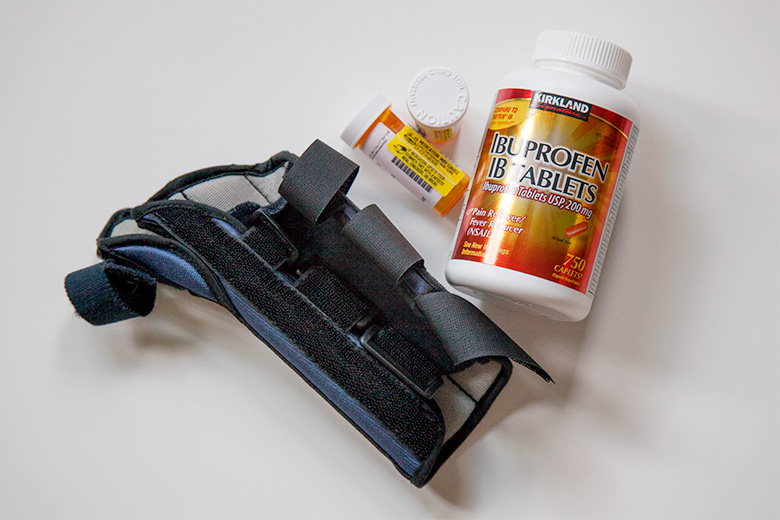
A couple of weeks ago I headed back in to see my doctor about the injury to my thumb I suffered when wrestling a bear in my back yard. See? I’ve mastered it! That’s the explanation I give now when someone tries to shake my hand and I have to very kindly decline.
“I would love to shake your hand, but I almost ripped my thumb off last month when I tackled a bear and stopped him from breaking into my house. No worries, he’s in stable condition and will eventually be let back into the wild.”
My doctor wanted to see if his course of treatment was making things better, especially given that he had taken me off prednisone and put me on another anti-inflammatory called meloxicam. I don’t think the new medication made any difference whatsoever, but at least it didn’t make me want to break plastic knives in half over my thigh while growling and plotting the destruction of at least ten different countries.

Sadly, my thumb felt worse due in no small part to the aching caused by the brace I was wearing to immobilize it. This is one of those instances where you have to hope that the benefits of the treatment far outweigh its side effects, and the potential gravity of these instances was driven home when I walked over to radiology to have a few X-rays taken of my thumb. The care and concern the radiologist took to cover my body with a lead apron to protect it from potential errant rays made this giant lightbulb go off in my head.
“The radiation used in these X-rays…” I began to ask the technician. “It’s the same radiation used to treat cancer patients, right?”
I think she thought that I thought I was in danger. “It is, but I can assure you that your hand is only getting a fraction of a second of exposure. And the exposure is very focused.” She was, in fact, turning that lightbulb on so brightly that it started to blind me.
“So if someone is undergoing radiation for cancer they are getting this same radiation in much larger doses?” I pressed.
“They are,” she answered. “Those treatments are focused as well, but yes. It’s one of those things where you hope you’re getting more of the good than the bad. You just have to hope.”
I think I intellectually understood what my mother is undergoing when she drives every single weekday up to the hospital: radiation. She’s being treated for cancer. This is the most effective approach. But I had not stepped out of that strict and sterile idea of it. I had not pulled myself out of the problem-solving part of my brain when it came to the actual procedure itself. My mother is being exposed in three to four different places on her chest to rays of radiation that can last up to 14 seconds. Every single day. Giant red burns span out across her body in sensitive, thickening scars.
We have to hope.
My X-rays didn’t show any broken bones or potential spurs, so he laid out three possible options about how to go forward. Two of them involved a shot of cortisone, and the other one involved another brace and more waiting. I chose option two immediately, apparently a little too immediately because he pushed his glasses very purposefully to the top of his nose.
“You do realize that it will hurt,” he said.
I looked around the room to see if he was talking to me.
“Of course it will hurt. It’s a shot. Shots normally hurt,” I responded.
“This is a little different—“
“I’m not afraid of a shot,” I assured him, and as he went to retrieve the supplies I broke out my phone and scrolled through Instagram with my left hand. What? If I get an Instagram injury on my left hand I promise I will make up a better story.
When he returned he said that most people are too afraid and only agree to the shot as a last resort. I guess I’ve known that I’ve become fascinated by the human capacity to endure pain, but right then I was able to articulate it for the first time.
“I was on vacation for the first time in a long time last year,” I started to tell him as he prepared the giant needle. “I had a week with no access to the Internet, no phone. And I didn’t even realize that the books I’d taken with me to read were all about humans overcoming excruciating physical pain.”
“There is a name for that. It’s called sadism,” he joked.
“Very funny,” I said. “I’m more interested in what the brain does when confronted with a certain level of, well, torture. Like, when I had an unmedicated birth with my second child, my brain eventually took me… I don’t know… someplace else when the pain became unbearable. Maybe it’s some sort of unconscious, self-imposed hypnosis? The same thing happened when I ran a marathon. I could feel the pain, but I was looking at it from outside my body. And that was the only reason I was able to finish.”
(If you share this same fascination you will love Unbroken: A World War II Story of Survival, Resilience, and Redemption and Into Thin Air: A Personal Account of the Mt. Everest Disaster
)
I was talking to avoid watching him stick the needle directly into the base of my thumb, and when he did I understood what he meant by “a little different.” Shooting flames of pain fanned out into every part of my hand, and then he had to wiggle and move the needle for several seconds. I’m sure I winced or maybe even groaned. It was extraordinarily uncomfortable, but then it was over.
“Put that one down in your pain journal,” he said as he stood up to throw away the materials.
And look! I have done exactly that! Here, let me be more formal about it:
“Cortisone shots hurt like a motherfucker, but I’m going to guess that coming close to freezing to death at the summit of Mt. Everest, or, say, radiation treatment for breast cancer? Those are a little more disagreeable.”
There.
That was two weeks ago. My thumb isn’t any better. In fact, it’s gotten so bad that I cannot hold a pencil. I’m now exploring other doctors and options that were suggested to me when I first wrote about hospitalizing that bear.
